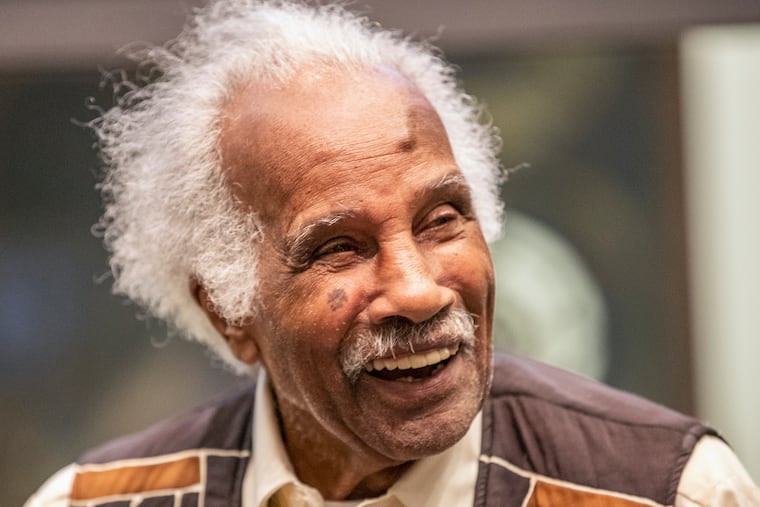Renowned African American author and artist is honored with a new archive at Penn
The vast collection includes 80 years of Ashley Bryan's papers, journals, sketches, paintings, puppets, books, photographs and more from a lifetime of making and collecting.

The artist and author Ashley Bryan, 96, rose from his chair, slowly, and looked out at a few hundred fans and archivists gathered to welcome him on Thursday evening.
Conversation at the Kislak Center for Special Collections at the University of Pennsylvania’s Van Pelt-Dietrich Library Center ceased. And then Bryan’s booming voice, hardly muffled by age, filled the room with words he’d spoken many times before, the poem My People by Langston Hughes:
“The night is beautiful, / So the faces of my people.”
His audience, hardly daunted, responded: “The night is beautiful, / So the faces of my people."
The famous verse became a biblio-call-and-response: the tall artist, with his curls of gray hair, keeping a beat with his long, thin fingers, eyes closed, to the end; the audience of archivists, students, family, and friends carried along in the moment.
“Beautiful, also, is the sun. / Beautiful, also, are the souls of my people,” Bryan said, keeping the beat. And the response, the same.
Then it was down to business. Bryan is one of the most celebrated, distinguished, and persistent authors of children’s books in the world. He has received virtually every award it is possible for a children’s book author to receive over a career that began in the early 1960s.
He is one of the main reasons children’s books now routinely feature people of color — a sea change from when he first illustrated and published African tales as well as volumes such as Rabindranath Tagore’s book of poems, Moon, for What Do You Wait?, in the 1960s.
Penn has now acquired Bryan’s massive archive of drawings, journals, sketchbooks, paintings, correspondence, sculptures, stained glass, puppets, ephemera, and on and on — a collection that stretches back nearly 80 years.
Bryan’s illustrated books include ABCs of African American Poetry, African Tales, Uh-Huh, All Night, All Day: A Child’s First Book of African American Spirituals, Dancing Granny, and Beautiful Blackbird. He has received the Laura Ingalls Wilder Medal and the King–Hamilton Award from the American Library Association, and many other honors.
Most of the material has already arrived at Kislak, said senior curator Lynne Farrington, with more to come from Bryan’s home of the last half-century, Little Cranberry Island, Maine.
The Bryan collection presents “an amazing diversity of genres," Farrington said. There are watercolors and linoleum cuts, pencil sketches and oil paintings. A small taste of the material is displayed in a pop-up exhibition on the sixth floor of the Van Pelt-Dietrich Library — all related to Bryan’s most recent book, Infinite Hope, published just over a month ago.
Farrington could not estimate the size of the archive other than to say it’s enormous. But she said that once the material “is processed,” a large Bryan exhibition will be mounted.
Infinite Hope is mined from Bryan’s past. It is a memoir of his time in the segregated Army during World War II, an experience that has haunted him since he was drafted in 1942 and was assigned as a stevedore in an all-black unit, eventually shipping out to Normandy for D-Day.
“It’s one hell of a book,” said Dan Lief, a board member of the Ashley Bryan Center, which has been the steward of the archive.
Why did such a prolific artist wait so long to write about the war?
“Vets don’t generally talk about their experiences,” said Bryan. For one thing, “there are not enough services” to help with emotional difficulties. For another, the segregated Army was not a happy place to be for a black man.
“My hope is the book will reach people of all ages,” he said. It contains “all the thoughts and ideas of my life in the war years.”
Born in Harlem and raised in the Bronx, Bryan studied art at Cooper Union School of Art as the school’s only African American student at the time. The archive contains correspondence and other material from his student days.
When he was drafted out of Cooper Union, Bryan maintained a sense of humanity by keeping a sketchbook and drawing as much as possible. The fruits of that effort are on display at Penn and were used for Infinite Hope.
After the war, Bryan returned to New York and finished at Cooper Union, and used the GI Bill to complete graduate studies in philosophy at Columbia University. Then came a Fulbright scholarship for European study.
He was, he said, looking for an answer to a haunting question: “Why does man choose war?”
What did he discover?
“I thought I’d get an answer. Well, I got more questions.”